BP Gulf Oil Disaster: Introduction and a look back at one of the worst environmental disasters and largest offshore oil spill in U.S. history.
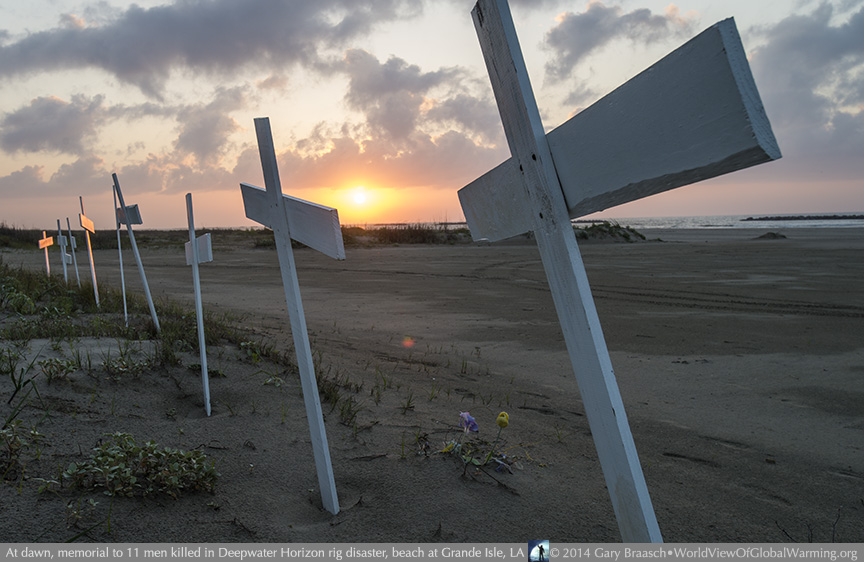
On April 20, 2010 the Deepwater Horizon rig drilling an oil well 50 miles SE of Venice LA exploded, killing 11 workers, injuring 26 others and unleashing an estimated more than 200 million gallons of crude into the Gulf of Mexico from the wellhead a mile underwater, until it was capped 87 days later in mid-July. The spreading oil, and the 1.8 million gallons of chemical dispersant that was sprayed over huge areas of the Gulf waters, killed an estimated one million birds, killed or contributed to the deaths of hundreds of dolphins and sea turtles, choked off the rich Gulf shrimp and fish industry throwing thousands out of work from New Orleans to the smallest native villages in the Delta, brought to a halt the multi-billion dollar Gulf tourist influx that spring and summer, and set in motion many scientific and health studies and changes to the management of offshore oil drilling by the U.S. government and the petroleum industry.
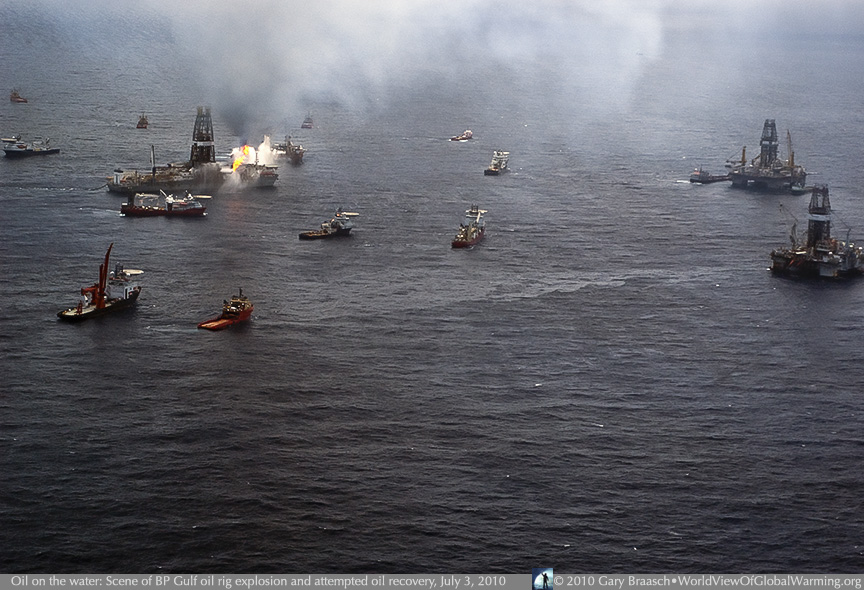 .
.
Much of the visible damage to beaches and waters is gone, thanks to natural processes and the thousands of workers BP hired to clean beaches. A great deal of the crude oil sank, covering about 3000 square miles of the Gulf ocean floor; the effects of that on the ecosystem will be studied for years. The BP and government response to the damaged Delta landscape, jobs, wildlife and health has cost many billions of dollars and is still awaiting final financial charges to BP. The extent of damages is vast, it is a long way from being known in full, and many issues are still being studied and are controversial scientifically and legally.
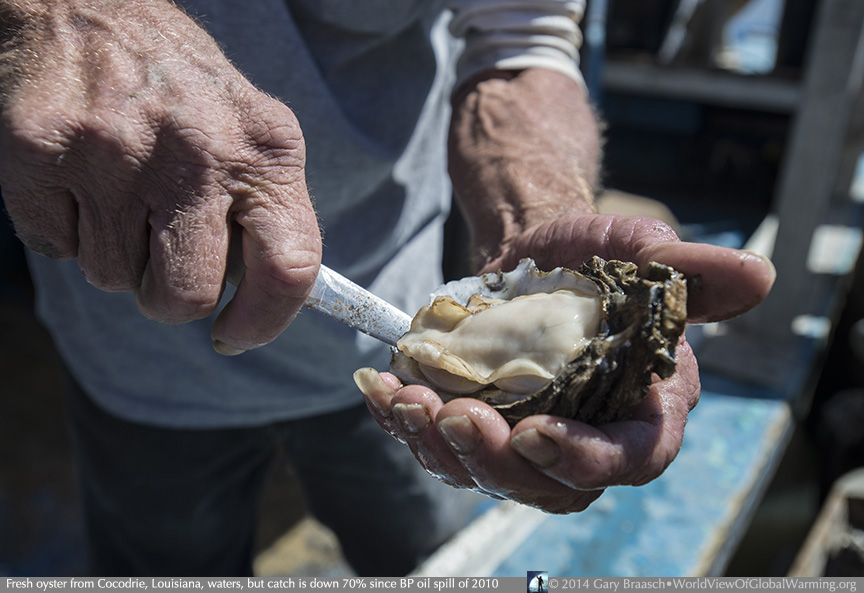
Major issues remaining include the fate of the oyster industry in Louisiana, which suffered nearly a 70 percent decrease in harvest in the years since the oil spill; the long-term health of people and oil workers which is being studied in a National Institutes of Health research project; and the long term problem of subsidence and destruction of Mississippi Delta land, largely from oil exploration and river channelization — it is among the projects being paid for by BP’s payments for the spill. The federal government rearranged the policy and enforcements arms of the Interior Department to tighten safety procedures, but not only has the amount of offshore oil drilling increased, more areas have been proposed for exploration in the Atlantic Ocean and Shell oil is nearing approval for drilling in the Arctic. Interior Department records show that there has been an average of more than 850 reported offshore oil spill incidents a year from 2010 to 2014, all smaller than the Gulf spill.
Extensive reviews of the oil spill are available on Grist, at the Smithsonian Institution and the Encyclopedia of Earth.
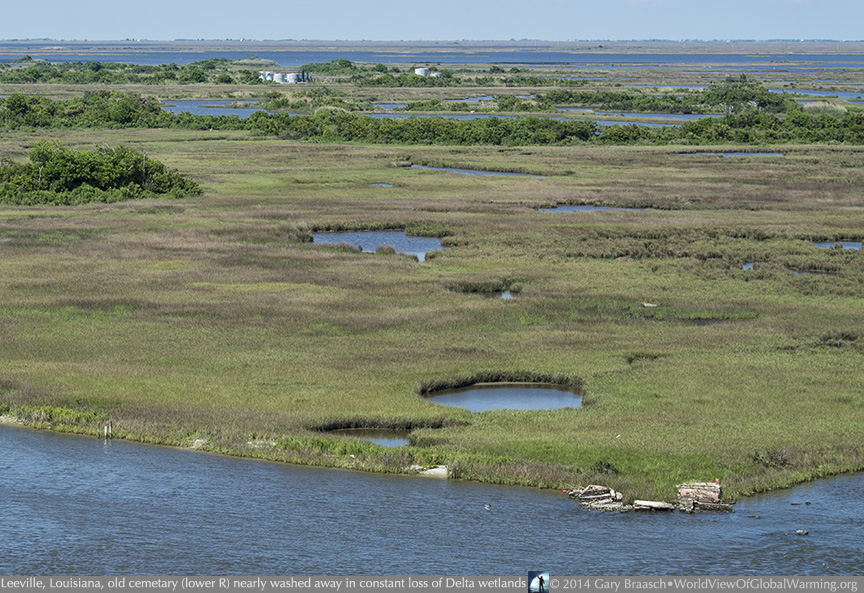
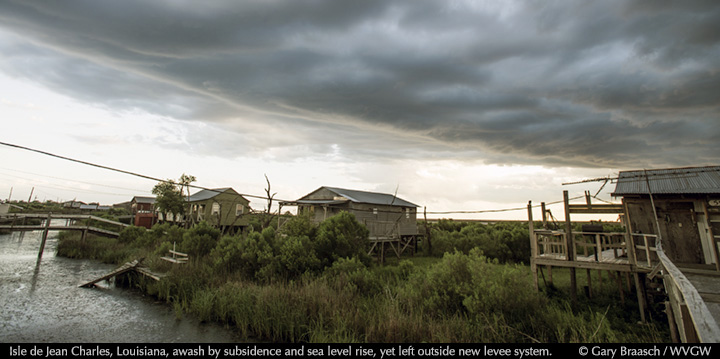
The following photo-reports by World View of Global Warming were photographed and put on line during 2010 and 2011 during and after the two months that Gary Braasch and Joan Rothlein were in the Gulf region — from Florida through the bayous and beaches of Louisiana to the endangered sea turtle nesting beaches of Mexico.
Updated April 21, 2011
A year ago, the BP Deepwater Horizon rig drilling into the Macondo oil field a mile deep in the Gulf of Mexico exploded and sank. Eleven workers on the rig were killed. The collapse of the rig and drill pipe unleashed the largest marine oil spill in history, 4.9 million barrels (207 million gallons), only about 50 miles SE of the Mississippi River Delta.
Over the nearly 3 months that the oil gushed out of the broken undersea pipe while BP tried to stop it, the surface slick reached a one-day maximum of 29,000 square miles (75,000 square km). In total 68,000 square miles (176,119 sq km) of the gulf, including about 800 miles of marshes and beaches, were touched by the oil in some form as it was pushed by wind and currents. BP used a huge amount of chemical dispersant both at the gusher site underwater and on the surface: 1.8 million gallons of Corexit 9500 and 9527. (Estimates of the oil extent by SkyTruth at www.skytruth.org. For a detailed timeline and history of the oil spill, response and ongoing science, please see the Encyclopedia of Earth).
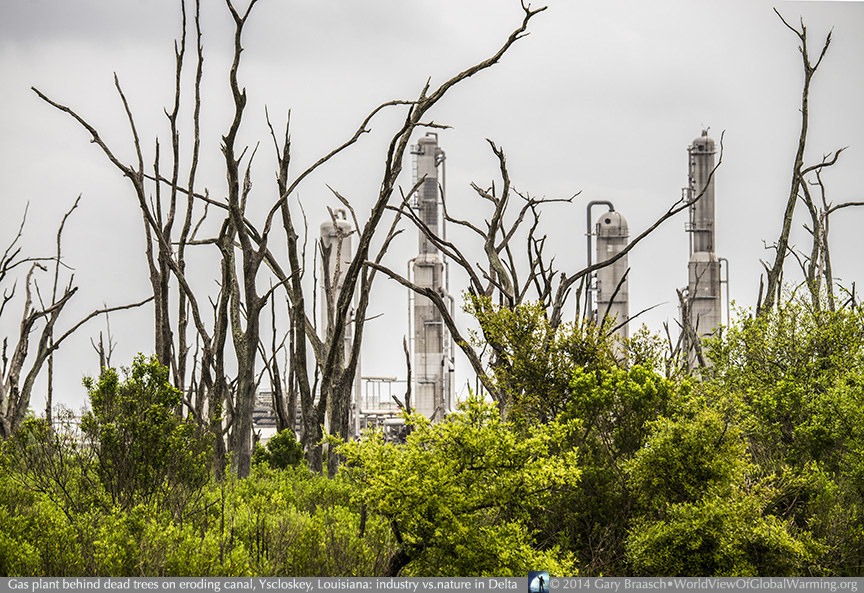
Tens of thousands of fishers, oystermen, crabbers, oil rig workers, tourist employees and hotel, shop and restaurant owners, and many who support them, were thrown out of work. Most have since returned to their jobs as areas are tested clean of oil, but some localities and occupations, like oyster harvesters in Louisiana, remain hard hit. Delta oyster beds, most of which were damaged not by oil but by release of fresh water down the river to try to keep the oil out, remain largely unproductive. NOAA this week reopened to commercial and recreational fishing 1,041 square miles of Gulf waters immediately surrounding the Deepwater Horizon wellhead, completing the reopening of all of the areas in Federal waters formerly closed due to the oil spill. Markets for Gulf seafood remain off apparently due to lingering concern over the safety of the fish and shrimp.
More than 47,000 federal, state and local people were employed in the clean up operation, and more than 2000 remain on the job today. Billions in economic losses were suffered from Texas to Florida. The independent payment system so far has authorized more than $3.8 billion to be paid to those affected from BP's $20 billion compensation fund, and more than a half-million claims have been submitted. The first nine bills submitted by the US Government to BP for expenses in fighting the oil have been paid in full, totaling $632 million, and a tenth was sent on March 10. The total amount that BP may owe under oil pollution and clean water laws -- not to mention invoices from states and expected lawsuits -- may take years to determine and be paid.
Some of that cost will be determined by the legally-required National Resource Damage Assessment
which is managed by NOAA. This will spell out BP's obligation to fund the complete restoration of injured public resources, including the loss of use of those resources by the people living, working and visiting the area. However, scientists working for NOAA on the Assessment can't talk about or publish their research findings until the government makes its case against BP, which could take months more. In addition, research into the spill which BP said last summer it would fund up to $500 million has been delayed. After BP gave out a tenth of the amount, negotiations with states over who would sit on the committee to select the studies for the remaining $450 million stretched on until last month. The committee has yet to review any research proposals, according to an NPR story.
Many scientists with other funding are studying the effects of the oil on workers, communities, seafood and other sea life and habitats. For example: Wilma Subra,, an independent chemist allied with the Louisiana Environmental Action Network, has found persistent traces of potentially cancer causing chemicals from the oil in people and seafood. A Woods Hole Oceanographic Institute study (A more current study of dispersants is available here.) found that dispersants were still in some parts of the Gulf months after their use Writing in Nature Geoscience, Samantha Joye of University of Georgia, the first to discover underwater plumes of oil early in the spill, and colleagues estimated that about 500,000 tons of hydrocarbon gases were released into the Gulf by the spill. A Federal study reported on www.restorethegulf.gov/ confirms that on many visibly clean beaches there are layers of oil beneath the surface which could taint the eggs of nesting sea turtles. The National Institutes of Health has begun a study on the long term health effects on up to 75,000 clean-up workers who came in contact with oil and dispersant on the job. Many scientific studies will not be completed for years.
Recent reports on effects of the oil may be read in the NY Times and here, and Wall Street Journal. Reminders of the longer-term threats to the Gulf and the Mississippi Delta may be read here and on the portfolios on this website (below).
A national commission to study the oil rig explosion and oil spill concluded that the event "could have been prevented and was caused by a series of mistakes" by BP, its contractor Halliburton and Transocean, who owned the rig. It said that deepwater oil exploration "has risks for which neither industry nor government has been adequately prepared" and that "fundamental reform will be needed in both the structure of those in charge of regulatory oversight and their internal decision making process to ensure their political autonomy, technical expertise, and their full consideration of environmental protection concerns." The commission called for the oil industry to increase "dramatically" the safety of drilling and the ability to respond to and clean up oil spills -- neither of which have kept pace with the technology for drilling in deep water. Even though the Interior Department did separate the functions of the Minerals Management Service -- renamed the Bureau of Ocean Energy Management, Regulation, and Enforcement --- to make inspection and enforcement more independent, the agency says (reports) that it has neither the funding nor the personnel to adequately monitor the industry. The writer Carl Safina and others have pointed out that despite BP's willingness to pay the full tab for the disaster, the Federal law remains in place requiring only $75 million in payments for an oil spill.
As of the week of April 11, 2011, according to the official wildlife count maintained by NOAA at www.restorethegulf.gov/fish-wildlife , 1,149 sea turtles were found dead or affected by the oil, and 809 of those were Kemp's ridleys, the most endangered of the five species in the Gulf. Total number of dead birds collected was 8233 and about 3000 were found alive and brought to cleaning and rehabilitation centers. These are just the official numbers. How many more turtles, birds and marine mammals died without being found, or were caught in BP's oil burns, may never be known. In the Northern Gulf, an unusual number of strandings and deaths of turtles and dophins is occurring this spring, according to NOAA. ] 194 dead stranded turtles have been found since January 2011, and a sampling of 26 animals showed no visible external or internal oil; the most common apparent cause of death was drowning, such as from being caught in nets or being affected by a biotoxin. NOAA said tests are continuing. More about sea turtles in the stories below.
Photo Reports Intro
1. The BP Deepwater Horizon oil well gushes crude across the Gulf to beaches and marsh.
2. Crude comes ashore from Gulf Shores to Grand Isle.
3. Clean up workers and local people react to the oil.
4. Oil in the marshes greases up birds and sedges; fishing and shrimping are closed.
5. Shrimping and fishing begin to return but long term effects of oil remain.
5A. The toll on animals and birds continues; rescuers take action.
6. Indians Face Oil Spill
7. Indians Face Oil Spill 2
8. The most endangered sea turtle and the Gulf oil spill 1
9. The most endangered sea turtle and the Gulf oil spill 2
COPYRIGHT NOTICE:
Photography and text Copyright © 2005 - 2017 (and before) Gary Braasch All rights reserved. Use of photographs in any manner without permission is prohibited by US copyright law. Photography is available for license to publications and other uses. Please contact requestinformation@worldviewofglobalwarming.org. View more of Gary Braasch's photography here.


